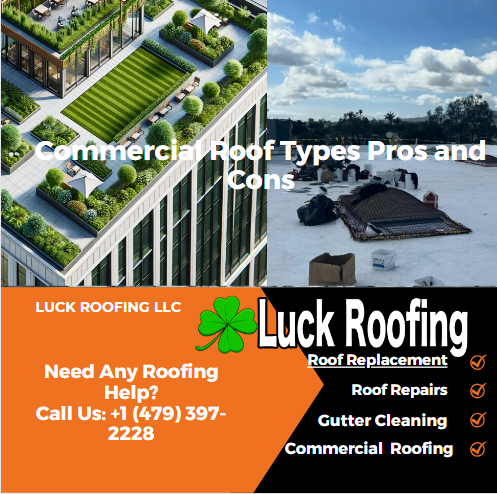
Commercial Roof Types Pros and Cons
When it comes to commercial properties, the choice of roof type is a critical decision that directly impacts the building’s functionality and longevity and lifespan.
With a myriad of options available, ranging from Metal Roofing to Green Roofing and Single-Ply Membrane systems, each option presents unique advantages and considerations.
Understanding the nuances of these roof types is essential for property owners and developers to make informed choices that align with their specific needs and objectives.
By exploring the diverse landscape of commercial roof types, one can gain valuable insights into the factors that drive decision-making in the domain of commercial construction.
Key Points In This Article
- Metal roofing offers exceptional durability and sustainability, lasting 40-60 years with modern coatings.
- Built-Up Roofing Membrane provides cost-effective waterproofing with multiple layers for durability.
- Green roofing improves air quality, reduces energy costs, and manages stormwater runoff effectively.
- Spray-On Roofing, using SPF material, creates a seamless, energy-efficient protective barrier lasting up to 50 years.
If you’re facing any problems with your commercial roof, our top-tier repair services in Arkansas are at your disposal. Luck Roofing offers superior roofing solutions to the community in Fort Smith and the surrounding areas. Don’t hesitate to reach out to us at (479) 397-2228 for professional advice. Rest easy knowing that your roofing project will be handled with the outstanding quality and dependability that we’re known for.
Metal Roofing
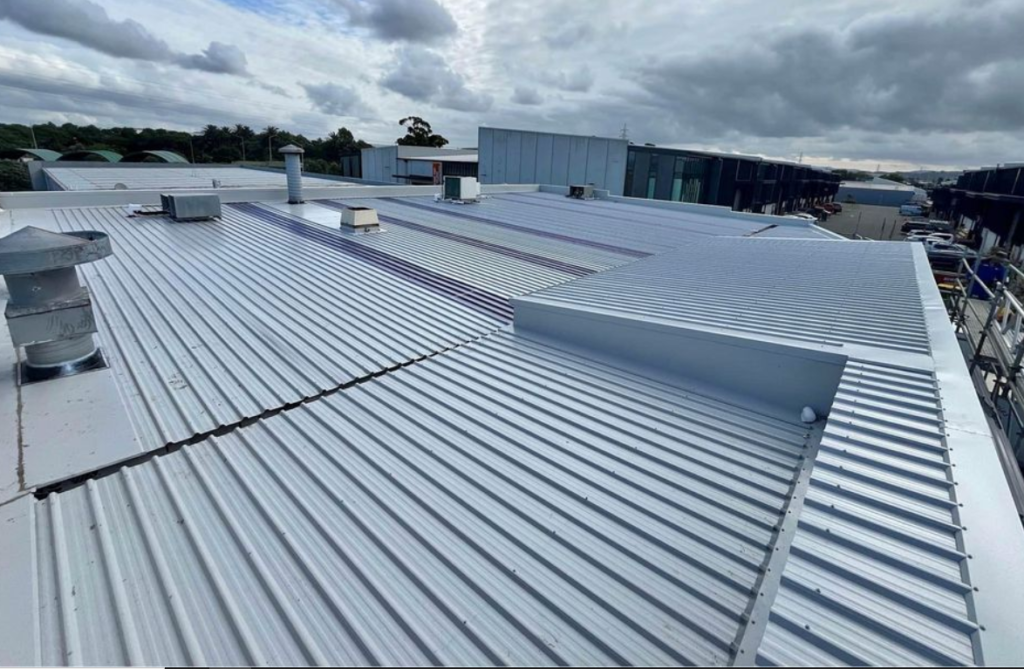 Metal roofing, known for its exceptional durability and longevity, is a popular choice for commercial buildings seeking a reliable roofing solution. With a lifespan ranging from 40 to 60 years, metal roofing stands out as a durable and long-lasting option. Commonly crafted from materials such as corrugated steel, aluminum, and copper, metal roofs offer strong fire resistance and sustainability, making them a practical and eco-friendly choice for businesses.
Metal roofing, known for its exceptional durability and longevity, is a popular choice for commercial buildings seeking a reliable roofing solution. With a lifespan ranging from 40 to 60 years, metal roofing stands out as a durable and long-lasting option. Commonly crafted from materials such as corrugated steel, aluminum, and copper, metal roofs offer strong fire resistance and sustainability, making them a practical and eco-friendly choice for businesses.
Learn about : Underlayment For Metal Roofs
One key advantage of metal roofing is its ability to withstand fire hazards, providing an added layer of safety for commercial properties. Additionally, modern coatings applied to metal roofs help manage corrosion, ensuring they remain resilient against environmental factors. This durability makes metal roofing a cost-effective solution in the long run, requiring minimal maintenance over its extended lifespan.
Moreover, the versatility of metal roofing extends beyond its longevity and durability. Various types of metal roofing are available, some featuring integrated solar panels or snow removal systems, adding functionality and energy efficiency to the building. This adaptability allows for customized designs that cater to the specific needs of commercial structures.
Built-Up Roofing Membrane
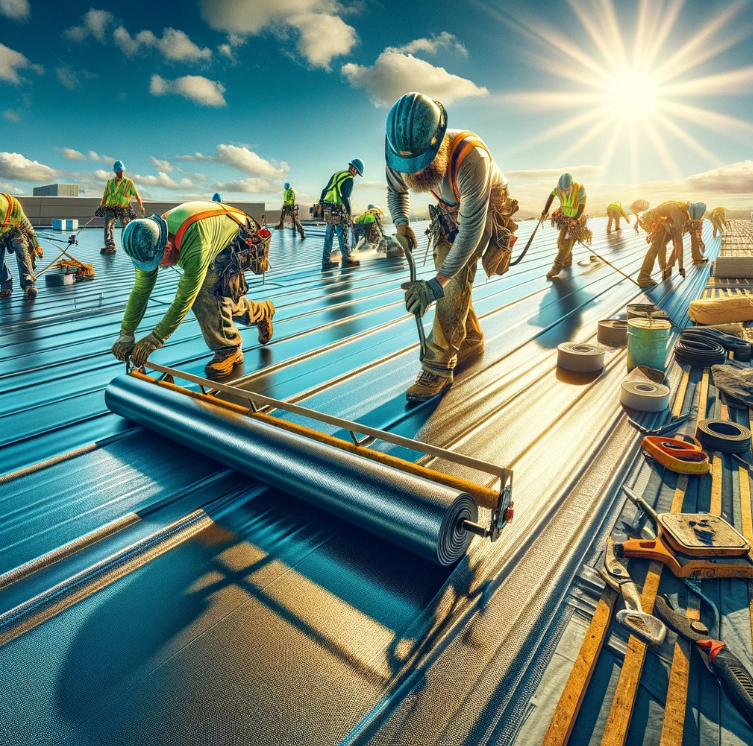
Built-Up Roofing Membrane, commonly referred to as BUR, is a roofing system composed of multiple layers that provide exceptional durability and waterproofing. BUR is highly effective at sealing against leaks and is known for its cost-effectiveness, making it a popular choice for low-slope applications. The multiple layers, or piles, in a BUR system consist of bitumen, reinforcing fabrics, and a top layer of aggregate or coating for UV protection and weather resistance.
| Layers | Description | Benefits |
|---|---|---|
| Bitumen | Provides waterproofing and serves as the adhesive | Excellent durability |
| Reinforcing Fabrics | Adds strength and stability to the roofing system | Enhanced structural integrity |
| Top Layer | Aggregate or coating for UV protection and weather resistance | Protects against elements |
While BUR offers great waterproofing benefits, it is important to note that it can be slippery when wet due to its composition. This roofing system is recommended for low-slope applications and buildings where weight is not a concern, as it tends to be heavier compared to other roofing systems. BUR is easy to install, especially for contractors with expertise in BUR installation techniques, further adding to its appeal in commercial roofing.
Green Roofing
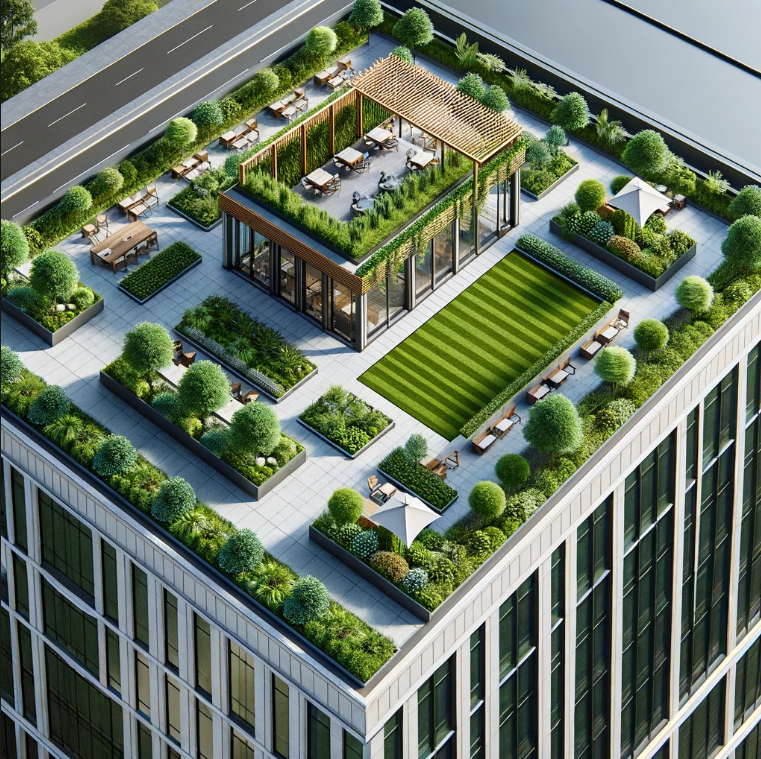
Green roofing systems, also known as vegetative roofs, consist of a waterproof membrane layer integrated with plants to create eco-friendly and visually appealing rooftop spaces. Green roofs offer a multitude of benefits that align with sustainable building practices and environmental consciousness:
- Improve Air Quality: Green roofs help purify the air by absorbing carbon dioxide and releasing oxygen, contributing to a healthier urban environment.
- Reduce Energy Costs: By providing natural insulation, green roofing systems can decrease heating and cooling needs, leading to energy savings for the building.
- Stormwater Runoff Management: These roofs help manage stormwater by absorbing and filtering rainwater, reducing the burden on drainage systems and minimizing the risk of flooding.
- Sustainable Building Practices: Implementing green roofs showcases a commitment to sustainability and environmental responsibility, potentially qualifying for incentives or certifications that promote green building practices.
- Longevity and Maintenance: With proper care, green roofs can last between 30 to 50 years, offering an enduring eco-friendly solution for commercial buildings.
Integrating green roofing systems into commercial buildings not only enhances the aesthetic appeal but also contributes significantly to environmental conservation and energy efficiency.
Spray-On Roofing
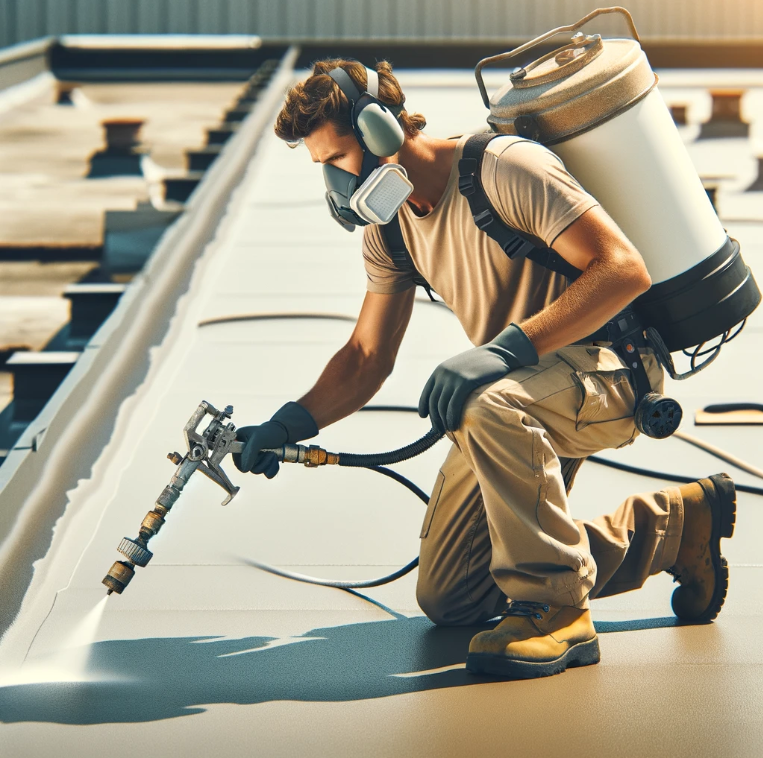
Spray-On Roofing, utilizing Spray Polyurethane Foam (SPF) material, is a versatile and efficient method for enhancing the waterproofing and insulation of commercial roofs. The SPF material expands into a foam layer, creating a seamless and durable protective barrier that can be applied on top of existing roofs. This process not only strengthens the roof structure but also improves energy efficiency by providing enhanced insulation properties.
One of the key advantages of Spray-On Roofing is its longevity, with proper installation and maintenance allowing it to last up to 50 years. This long lifespan contributes to the cost-effectiveness of this method in commercial roofing applications. Additionally, the energy efficiency of SPF material helps in reducing heating and cooling costs for the building, making it an environmentally friendly choice.
Regular roof inspections, recommended once or twice a year, are essential to ensure the integrity and performance of Spray-On Roofing systems. By monitoring the condition of the roof, any potential issues can be identified and addressed promptly, extending the lifespan of the roof and maintaining its waterproofing and insulation properties. Overall, Spray-On Roofing offers a reliable and efficient solution for commercial roofs, combining waterproofing, insulation, and energy efficiency in a cost-effective manner.
Thermoset EPDM Membrane
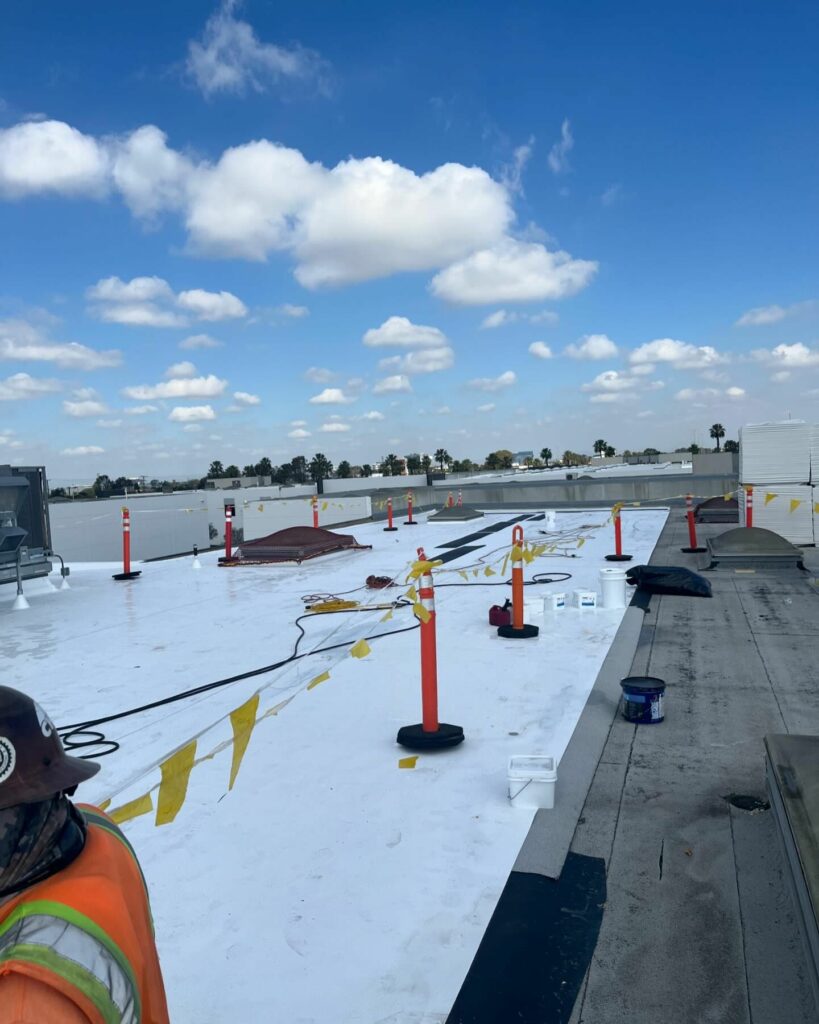
Is Thermoset EPDM Membrane a suitable choice for your commercial roofing needs?
Thermoset EPDM membrane, a synthetic rubber roofing material, is recognized for its exceptional durability and resistance to sunlight and pollution. This type of membrane is available in rolls, both white and black, providing flexibility in installation options. Here are some key points to consider:
- Durability: Thermoset EPDM membrane is highly durable, offering long-lasting performance on commercial roofs.
- Resistance: The membrane is resistant to common solvents, enhancing its longevity and maintaining its integrity over time.
- Installation: Proper installation is crucial for optimizing the performance of Thermoset EPDM membrane and ensuring its longevity.
- Maintenance: While durable, the membrane may be susceptible to punctures, emphasizing the need for regular maintenance to address any potential issues promptly.
- Aesthetics: Despite its practicality, Thermoset EPDM membrane may not be the most visually appealing option for those seeking an aesthetically pleasing commercial roofing system.
Considering the durability, resistance, and installation requirements of Thermoset EPDM membrane, it can be a suitable choice for commercial roofing needs, particularly for those prioritizing longevity and practicality over aesthetics.
Thermoplastic PVC And TPO Roof Membranes
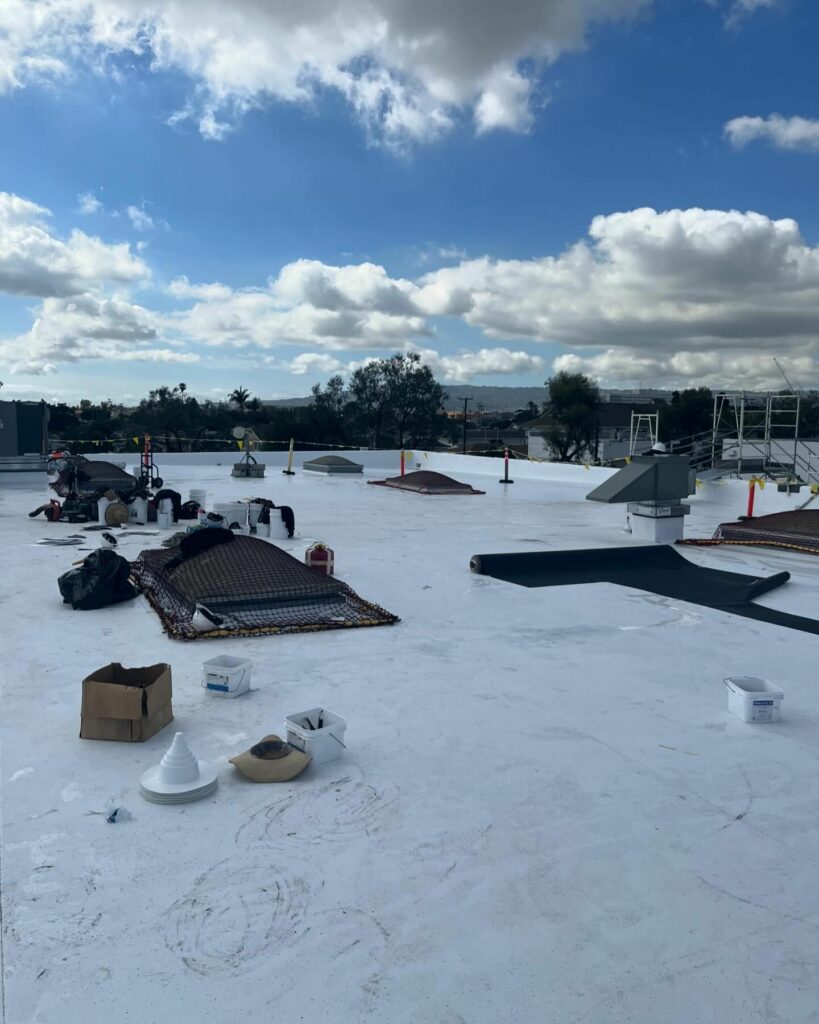
Thermoplastic PVC and TPO roof membranes, known for their lightweight composition and high reflectivity, offer energy-efficient solutions for commercial roofing applications. These membranes are designed to reduce energy costs by reflecting sunlight, thus decreasing the need for excessive cooling during hot weather. Their high reflectivity helps in maintaining a cooler indoor environment, contributing to lower energy consumption and operational expenses for commercial buildings.
In addition to their energy-saving benefits, thermoplastic PVC and TPO roof membranes exhibit exceptional weathering properties, making them resistant to UV light, punctures, tears, and chemicals. This durability ensures a long lifespan, reducing the frequency of repairs or a full roof replacement and providing a cost-effective roofing solution for businesses. The ease of installation further adds to their appeal, saving both time and labor costs during the roofing process.
Also Read : Our Full Guide on What Does a Commercial Roof Replacement Cost
Commercial properties benefit from the superior resistance these membranes offer against harsh weather conditions, ensuring minimal maintenance requirements over time. The flexibility and high performance of thermoplastic PVC and TPO roof membranes make them a popular choice in the commercial roofing industry, providing reliable protection and energy efficiency for various building structures.
Shingle Roofing
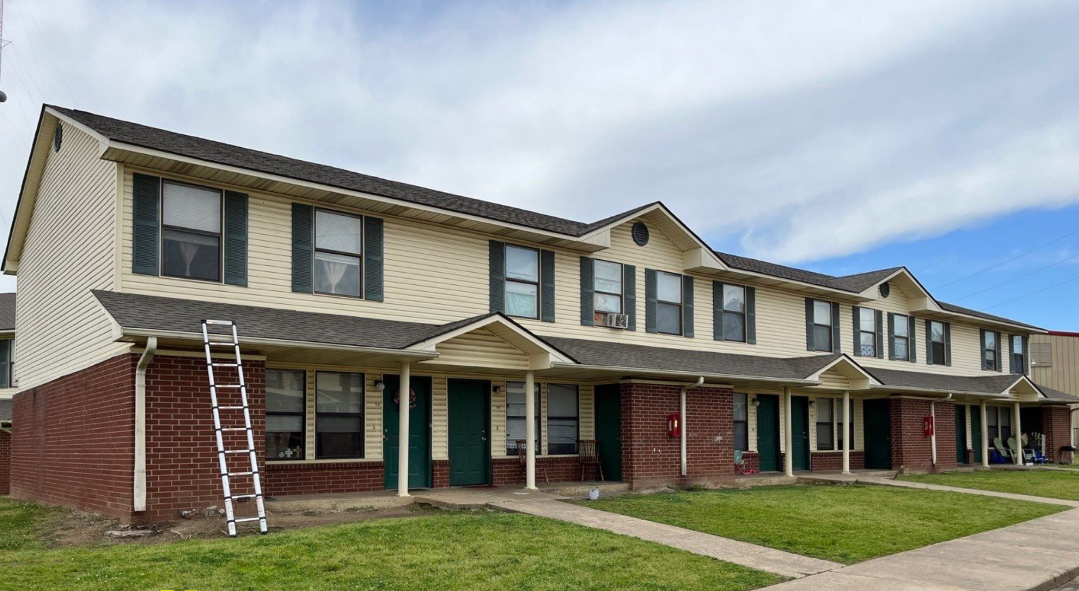
Asphalt shingle roofing is a commonly chosen material for commercial roofs due to its cost-effectiveness and durability. This versatile commercial roofing material is known for its suitability in various climates, offering a lifespan ranging from 15 to 30 years. However, regular maintenance and inspections are crucial to ensure the longevity of asphalt shingle roofs. Despite their affordability, asphalt shingles may require more frequent maintenance compared to other options like metal roofing.
Here are some key points to consider when opting for asphalt shingle roofing:
- Cost-Effectiveness: Asphalt shingles are a budget-friendly choice for commercial buildings, making them a popular option for many businesses.
- Durability: With a lifespan of up to 30 years, asphalt shingle roofs offer long-term protection and reliability.
- Versatility: Suitable for various climates, asphalt shingles can withstand different weather conditions, making them a versatile roofing option.
- Maintenance: Regular maintenance and inspections are essential to prolong the lifespan of asphalt shingle roofs and address any potential issues promptly.
- Climate Suitability: Their adaptability to different climates makes asphalt shingles a practical choice for commercial properties located in diverse regions.
Single-Ply Roofing Systems
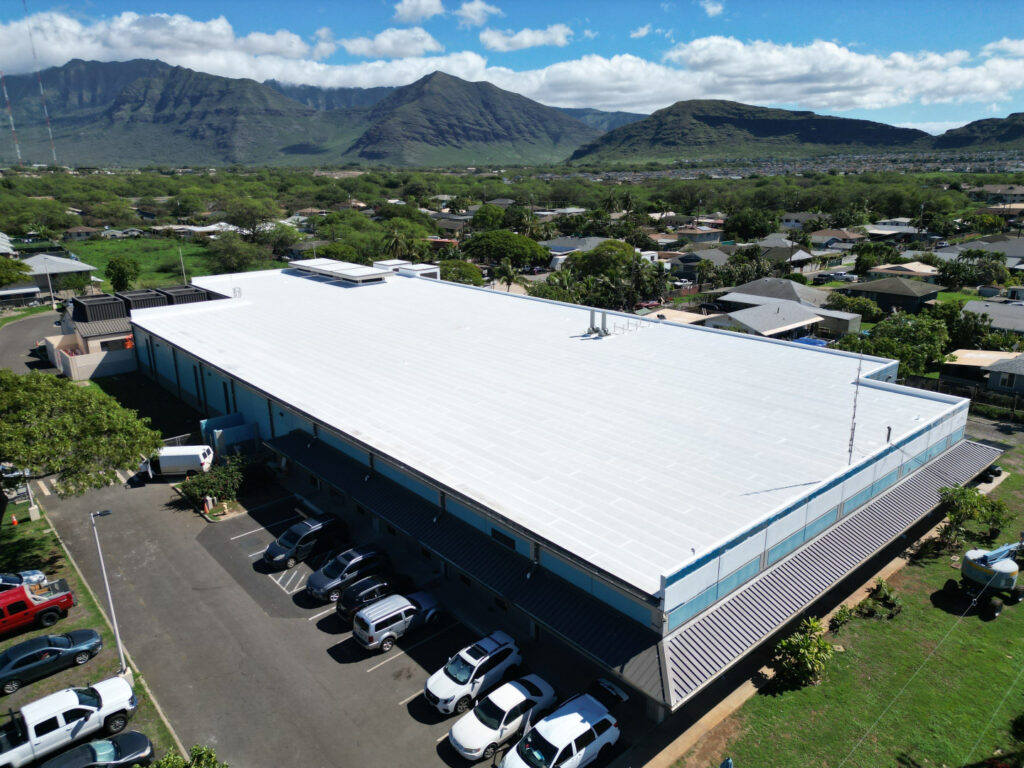
Single-ply roofing systems are widely favored in commercial flat roof applications for their remarkable flexibility and strength. These systems are typically constructed with three layers: a base, a scrim, and a top layer for enhanced protection. Single-ply roofing offers advantages such as heat-reflectivity and being lightweight compared to other roofing options. Despite these benefits, they may be susceptible to punctures and might not be as aesthetically pleasing as some alternative materials.
Below is a comparison table showcasing common materials used in single-ply roofing systems:
| Material | Flexibility | Strength | Common Use |
|---|---|---|---|
| TPO | High | High | Commercial buildings, hospitals |
| EPDM | Moderate | Moderate | Schools, warehouses, retail buildings |
| PVC | High | High | Restaurants, manufacturing facilities |
TPO membranes are known for their high flexibility and strength, making them suitable for various commercial structures like hospitals. EPDM membranes offer moderate flexibility and strength, commonly used in schools and warehouses. PVC membranes, with high flexibility and strength, are often seen in establishments like restaurants and manufacturing facilities. These materials provide weather resistance and durability, essential for long-lasting protection against the elements.
Modified Bitumen Roofing
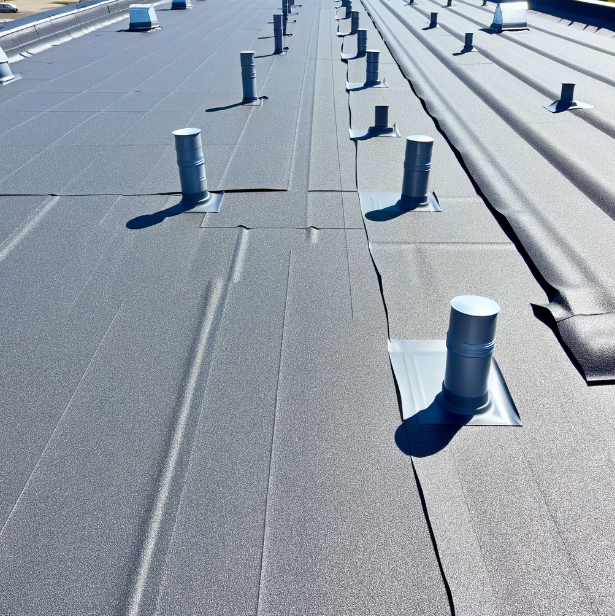
Modified Bitumen Roofing is a cost-effective option for commercial roofing projects known for its low initial costs and ease of installation using self-adhesive sheets. This type of roofing provides durability and waterproofing capabilities, offering reliable protection against leaks and water damage for commercial buildings. However, it typically has a shorter lifespan compared to other commercial roofing options, which should be considered when choosing the roofing material for a project.
- Low Initial Costs: Modified Bitumen Roofing is favored for its affordability, making it an attractive choice for budget-conscious commercial projects.
- Ease of Installation: The use of self-adhesive sheets simplifies the installation process, saving time and labor costs during construction.
- Durability: While not as long-lasting as some other roofing types, Modified Bitumen Roofing still offers good durability, standing up well to various weather conditions.
- Waterproofing Capabilities: The roofing material effectively prevents water penetration, ensuring the interior of the commercial building remains dry and protected.
- Maintenance Challenges: Despite its benefits, maintenance of Modified Bitumen Roofing can be demanding due to its slippery surface when wet, requiring careful attention for safety and upkeep.
When weighing the pros and cons of Modified Bitumen Roofing for a commercial project, considering factors such as budget constraints, expected lifespan, and maintenance requirements is crucial to making an informed decision.
Frequently Asked Questions
What Is The Most Common Type Of Commercial Roof?
The most common type of commercial roof is the single-ply roofing system. Offering flexibility, ease of installation, and weathering resistance, it has become a popular choice for many commercial buildings.
Known for its heat reflectivity, lightweight properties, and durability, single-ply roofing provides cost-effective protection against the elements. Its versatility and reliability make it a preferred option for flat or low-slope roofs in various industries.
What Is The Best Roofing For A Commercial Building?
When determining the best roofing for a commercial building, factors like durability, maintenance needs, energy efficiency, installation costs, and environmental impact must be considered.
Each roofing type offers unique benefits, such as cost-effectiveness, longevity, ease of installation, or environmental advantages.
Evaluating these factors in relation to the specific requirements of the building will help in selecting the most suitable roofing option that aligns with the building’s goals and budget.
What Is A Commercial Roof Called?
A commercial roof is commonly known as a flat or low-slope roof, specifically designed for commercial buildings. It is crucial to select the appropriate type of commercial roof based on factors like durability, maintenance requirements, energy efficiency, and cost-effectiveness to ensure the structural integrity and longevity of the building.
Proper installation and maintenance of the commercial roof are essential for its optimal performance and protection of the underlying structure.
What Are The 3 Main Types Of Roofs?
The three main types of roofs are flat roofs, low slope roofs, and steep slope roofs.
Flat roofs are commonly found in commercial buildings like warehouses and use materials such as EPDM, PVC, and TPO.
Low slope roofs, also known as low pitch roofs, require specific materials for proper drainage and protection.
Steep slope roofs, resembling residential roofs, often utilize materials like metal, shingles, slate, or tile for durability and aesthetics.
And To Finish
In the world of commercial construction, the selection of roof types is crucial for the performance and longevity of a building. Metal Roofing offers durability, while Green Roofing promotes sustainability.
Built-Up Roofing Membrane provides cost-effectiveness, and Single-Ply Roofing Systems offer easy installation. Understanding the unique attributes of each type allows property owners to choose wisely that align with their objectives.
By considering factors such as durability, environmental impact, and maintenance requirements, commercial roof selection can be optimized for functionality and cost-efficiency.
Michael Overzat
Michael Overzat resides in Fort Smith, Arkansas with his wife and three kids. He enjoys to hike, skateboard, write, and get involved in charity organizations. He was originally born in Maryland. He has worked within the roofing industry for 5 years and is very active within the industry by attending conferences, masterminds, etc. His vision is to create a multi-state organization that has a customer centric model. He's worked for some of the biggest names in the industry and hopes to create a more people focused model for the roof replacement process.
